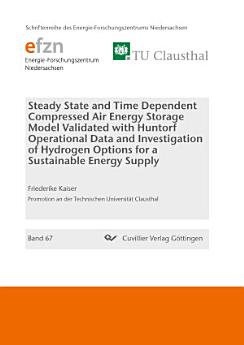Steady State and Time Dependent Compressed Air Energy Storage Model Validated with Huntorf Operational Data and Investigation of Hydrogen Options for a Sustainable Energy Supply
About this ebook
In this thesis, the calculation methods for the thermodynamics of the CAES process are presented and validated by measured data from the operations of the CAES power plant Huntorf. Both the steady state and the dynamic (time-dependent) analyses of the process take place. The characteristic value efficiency is discussed in detail, since numerous different interpretations for CAES exist in the literature. A new calculation method for the electric energy storage efficiency is presented, and a method for the calculation of an economically equivalent electricity storage efficiency is developed. Consideration is given to the transformation of the CAES process into a hydrogen-driven and, thus, greenhouse gas-free process. Finally, a model CAES system is tested in a 100 % renewable model environment.
Consequently, it can be stated that in the steady-state thermodynamic calculation in particular, the consideration of realistic isentropic efficiencies of compressors and turbines is essential to correctly estimate the characteristic values of the process. Furthermore, a steadystate view should always be accompanied by dynamic considerations, since some process characteristics are always time-dependent. The simulation shows that by mapping transient operating conditions, the overall efficiency of the system must be corrected downwards. Nevertheless, in the model environment of a 100 % renewable energy system, it has been shown that a CAES is a useful addition that can provide long-term energy storage.
About the author
Geboren 1987 in Marburg legte sie 2006 das Abitur am Justus Liebig Gymnasium in Darmstadt ab. Anschließend absolvierte sie bis 2009 das Studium zum Bachelor of Engineering Maschinenbau, Fachrichtung Verfahrenstechnik an der Dualen Hochschule Baden-Württemberg in Mannheim in Kooperation mit Evonik Röhm GmbH bei der wertvolle Praxiserfahrung unter anderem in den Unternehmensbereichen Produktion (Darmstadt, Weiterstadt und Worms), Engineering (Frankfurt-Hanau, ehemalige Degussa) sowie Bau und Inbetriebnahme (Shanghai, MUSC) gesammelt werden konnte. 2009 bis 2012 folgte dann das Studium zum Diplom-Ingenieur an der Technischen Universität Clausthal sowohl im Studiengang Chemieingenieurwesen als auch im Studiengang Umweltprozesstechnik. 2013 bis 2016 ist Friederike Kaiser beim Energie-Forschungszentrum Niedersachsen als wissenschaftliche Mitarbeiterin tätig.







